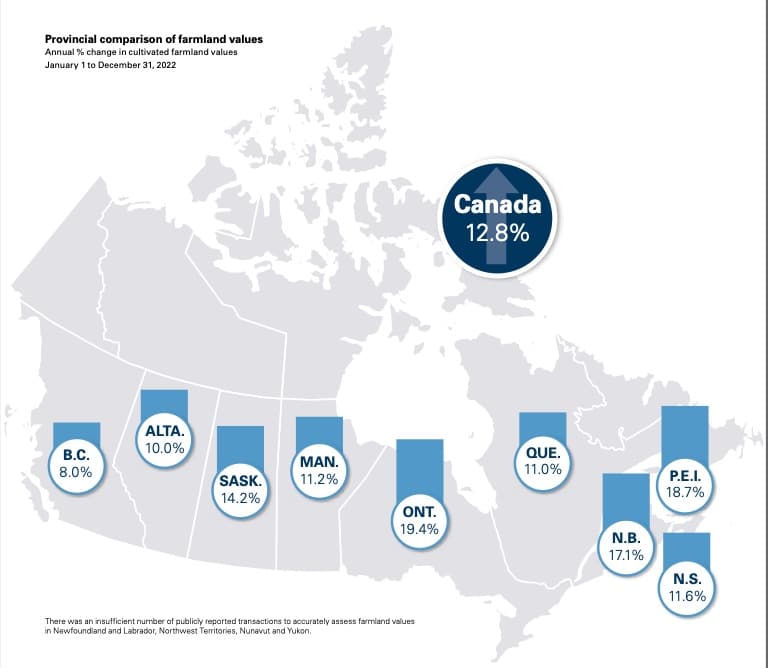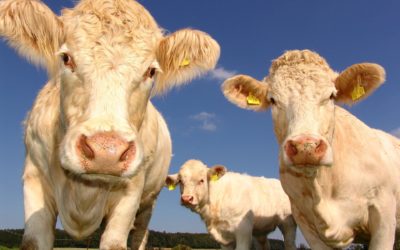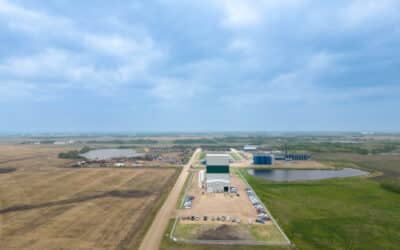Farmland prices in Alberta jumped by 10 per cent in 2022, which was below the national average of 12.8 per cent, according to the Farm Credit Canada (FCC) Farmland Values Report. The rise was supported by strong farm income, elevated input prices and rising interest rates, however the demand for farmland is remaining robust with the supply of farmland available for sale limited.
“Challenging economic conditions could have been expected to slow the demand for farmland and the resulting price buyers paid for land in 2022,” J.P. Gervais, FCC’s chief economist, said in the release. “But the underlying fundamental factors in the farmland market tell another story.”
Nationally farmland values saw the highest increase since 2014, following gains of 8.3 per cent in 2021 and 5.4 per cent in 2020. FCC estimates that receipts of grains, oilseeds and pulses in Canada have increased 18.3 per cent in 2022, and are projected to grow 9.4 per cent in 2023, the release noted.
“Higher farm revenues are driving the demand for farmland, but higher borrowing costs and increased input prices are expected to lead to declines in the number of sales in 2023,” Gervais said.
The highest average provincial increases in farmland values were observed in Ontario, Prince Edward Island and New Brunswick, with increases of 19.4, 18.7 and 17.1 per cent, respectively. Saskatchewan followed with a 14.2 per cent increase. Five provinces had average increases below the national average at 11.6 per cent in Nova Scotia, 11.2 per cent in Manitoba, 11.0 per cent in Quebec and 10.0 per cent in Alberta, the release said. British Columbia was the only province to have recorded a single-digit increase at 8.0 per cent, but it is also a market where land values are the highest on average.
Alberta’s increase followed average increases of 3.6 per cent in 2021 and six per cent in 2020, the release said. The highest increase in cultivated farmland values was observed in the Peace region for 2022 at 13.6 per cent. Changes in land values varied within the region, with the southern area of the Peace region posting increases of more than 35 per cent while other areas remained stable. The release noted areas that experienced a wet spring that negatively affected yields saw lower increases in value, while areas with above-average yields showed larger increases.
The northern and ventral regions both recorded an 11.5% increase in cultivated land values. With commodity prices remaining strong and supply-managed operations looking for land, the demand for cultivated farmland continued to grow in both the northern and ventral regions, the release noted.
The southern region of Alberta recorded the lowest increase in the province with a modest 4.4 per cent increase in values in 2022, excluding irrigated land ‚ in 2021, this region had the highest increase at 6.2 per cent. In the early part of the year in southern Alberta, there was notable pressure on smaller parcels of land in response to a strong residential market, the release said. While the demand tapered off in the later part of the year, values remained high.
Like other provinces, irrigated land in Alberta had a higher overall value than cultivated land or pastureland, the release noted. Irrigated land in the southern region witnessed an increase of 29.9 per cent in 2022, reaching record-high values. The increase was attributed to larger contracts for specialty growers, mainly potatoes, and to land coming for sale near major growers and storage sites.
Pastureland values in Alberta increased by 5.5 per cent in 2022. The most notable increases occurred in the northern region with an 11.8 per cent increase, followed by the Peace region at 8.4 per cent, the release said. These regions are where values per acre were the lowest. The central region experienced an increase in pastureland values at six per cent. The southern region saw the lowest increase in pastureland values, with a modest 1.6 per cent growth. However, the southern region held the highest value per acre in the province.
The release noted central Alberta pastures experienced slow growth in the spring due to cool weather followed by heat damage in the summer that caused producers to market calves earlier than normal.
There was an insufficient number of publicly reported sales in Newfoundland and Labrador, Northwest Territories, Nunavut and Yukon to fully assess farmland values in those regions, the release noted.
Related Articles
Canadian Farmland Values, Interest Rates on the Rise





